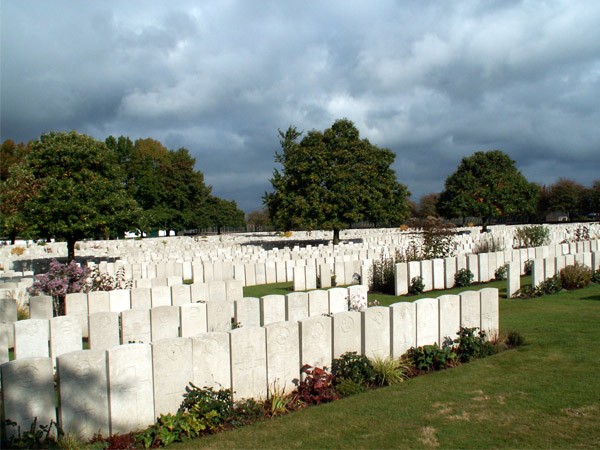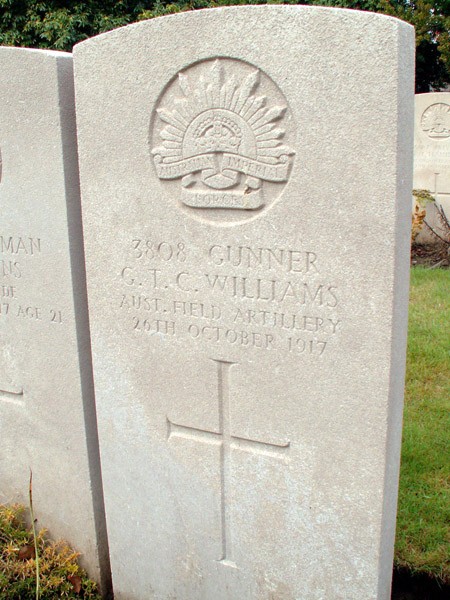Freelance writer Troy Wilkinson writes: For most of my life, G T C Williams was nothing more than a name. I wasn’t even aware of my great-grandmother’s brother existence until a family road trip aged 12. At the War Memorial in Canberra my grandfather found the name of an uncle he never met on the wall of the First World War Roll of Honour.
A general interest in genealogy grew within my extended family over ensuing years, but by that time it was already too late to ask anyone who had personally known George (or Clyde, as he preferred to go by) Williams, so it was his military record that has provided us most of the details of his short adult life.
Born in Tasmania in July 1893, Clyde was the second of nine children born to Annie and George Williams Snr. At some point after the outbreak of the First World War, Clyde joined the AIF as Serial Number 3808 and was assigned as a Gunner in the 5th Battery of the 2nd Brigade of the Australian Field Artillery. After undergoing combat training in Alexandria and Cairo in Egypt, Clyde was sent to Gallipoli, arriving there in July 1915, some months after the initial Anzac landings. His withdrawal from that now infamous peninsula came in November of that year, when a case of tonsillitis necessitated an evacuation to Malta, whereupon he returned to active service in Egypt.
In March 1916 he was shipped across the Mediterranean from Alexandria to the southern French port of Marseilles. Clyde’s record lists nothing more until May 1917, when near Lagnicourt in northern France he was wounded by exploding ammunition while saving an injured companion from a gun pit. Awarded the Military Medal for bravery, he was evacuated to the Bath War Hospital in England to convalesce. While in England he collected the only black mark on his record, receiving an official reprimand for being caught in town one evening without possessing a leave pass.
Later in 1917, Clyde returned to the Western Front, and was temporarily promoted to the rank of Acting Bombardier –presumably due to heavy Australian casualties. He was not to escape the carnage himself though, becoming seriously wounded for a second time, near the town of Ypres in October 1917. He ultimately died that same month at an Allied casualty clearing station, aged 24.
Clyde Williams’ story is hardly unique or significant when compared to the hundreds of thousands of other Australians who enlisted for the Great War, but that does not mean that it does not deserve any consideration on its own merit. And much the same could be said of the small market town on the Belgian-French border where I’d ventured to find his headstone.
Poperinge in West Flanders, population 10,000, is nothing more than an anonymous speck on Europe’s canvas of great cities, towns and noteworthy villages. Indeed, my visit here was but a short pit stop on my way to the far more storied and celebrated city of Bruges an hour’s drive to the north-east.
Surrounded by a patchwork of fields of hops and grain, Poperinge’s skyline is still dominated by the steeples of three churches dating from the 13th and 14th centuries, and at its centre is the Grote Markt, an old market square flanked at one end by a neo-gothic town hall. To a travelling Australian brought up in the modern and suburban it contains all the weathered and living history, and that dash of quaintness, that makes Europe such a draw.
Fortunately for Poperinge, unlike its historically more prosperous near neighbour Ypres (or Ieper in Flemish), much of it survived the First World War as the front lines of battle in the area over four long years came no closer than ten kilometres to the east. That proximity plus good road and rail connections close to the English Channel gave Poperinge an important role as a marshalling point for British and Allied troops, and a place of respite away from the muddy trenches and gas attacks in Ypres. Naturally it also became a base for field hospitals and casualty clearing stations.
It is perhaps that last function that has left Poperinge with the most visible reminders of this conflict — the graves for those wounded soldiers for whom medical care was not enough to save their lives. There are about ten WWI burial grounds that ring the town, some on the former sites of the field hospitals, and I was bound for Lijssenthoek Military Cemetery, the largest of these. Situated in a peaceful rural plot between the southern edge of town and the border with France, it contains almost 10,000 Commonwealth graves, along with small numbers of others — mostly French and German.
Despite my wife and I being the only visitors on a blustery and overcast October morning, the neatly mowed lawns and the rows upon rows of identical white stone slabs remain remarkably well tended. And thanks to excellent online resources, the headstone we were searching for was surprisingly easy to find. While standing in front of Clyde Williams’ memorial, and surrounded by the sombre reminders of thousands of other men cut down in their prime, I had to wonder why he enlisted for the AIF in the first place. Was it out of some inherent loyalty to “King and Country”? Or perhaps the easiest way for a young, working class Tasmanian bloke to have a grand overseas adventure and see some of the world?
I’m a few years into my own such journey, and co-incidentally have been to almost all the places listed in Clyde’s military record. As Anzac Day approaches, I can only be thankful my personal travels across the world have been so exceptionally idyllic. I really have been fortunate to so easily visit this average Belgian town, and, more than ninety years after a young Clyde Williams was mortally wounded here so far away from home, to have most likely been the first descendant to ever visit his grave.
You can read more of Troy at his blog Troy’s Gone Walkabout.









Crikey is committed to hosting lively discussions. Help us keep the conversation useful, interesting and welcoming. We aim to publish comments quickly in the interest of promoting robust conversation, but we’re a small team and we deploy filters to protect against legal risk. Occasionally your comment may be held up while we review, but we’re working as fast as we can to keep the conversation rolling.
The Crikey comment section is members-only content. Please subscribe to leave a comment.
The Crikey comment section is members-only content. Please login to leave a comment.